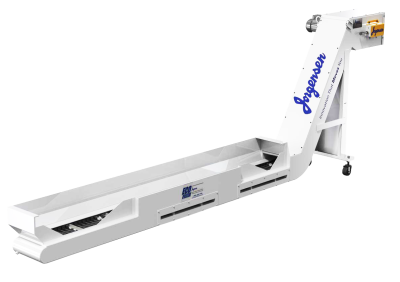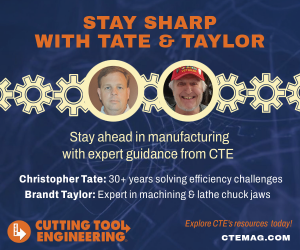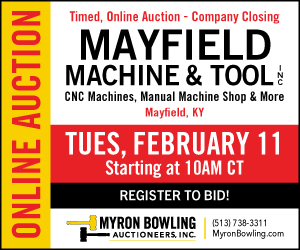
Improving on its industry-leading, two-stage chip removal and coolant filtration design, Jorgensen Conveyor and Filtration Solutions now offers affordable, enhanced filtering capability on the acclaimed EcoFilter Conveyor. It does so with an all-new filter box configuration that enables efficient filtration of fine chips to 80-micron nominal. Called the EcoFilter 80, it is the first economical non-drum style conveyor below 100-micron filtration.
The new conveyor provides shops an additional option to Jorgensen’s EcoFilter 200 that provides fine chip filtration to 200 microns and was the first competitively priced conveyor and filtration system for all levels of turning and machining centers. The overall design and footprint of both conveyors are similar with the significant difference being the increased filtration of the EcoFilter 80’s filter cell.
EcoFilter conveyors use a two-stage chip removal and filtration process that carries out large chips on a hinged or scraper belt. Fine chips flow with used coolant between the belt runs to a flow-through EcoFilter cell where they are separated from the coolant. Clean coolant is discharged to the coolant tank while filtered fines are brushed from the filter screen and flow to the bottom of the conveyor where they are picked up by the belt cleats and discharged.
By dramatically reducing the number of chips that migrate to a machine tool cooling tank, the amount of downtime for tank cleaning and maintenance are significantly reduced while improving pump, tooling and coolant life. The EcoFilter is environmentally friendly; it uses no consumables, and the single-drive design reduces energy consumption. As a result, shops gain increased production and profitability.
The design integrates with either hinge steel belts or drag flight chain style conveyors. EcoFilter easily fits most machining centers and lathe envelopes from small to large, accommodating a broad coolant flow rate via flexible filter cell sizing. Additionally, all current EcoFilter-ready conveyors can be considered for an EcoFilter 80 field retrofit. EcoFilter conveyors can be custom engineered for a variety of lengths, widths, heights and incline angles.
Contact Details
Related Glossary Terms
- centers
centers
Cone-shaped pins that support a workpiece by one or two ends during machining. The centers fit into holes drilled in the workpiece ends. Centers that turn with the workpiece are called “live” centers; those that do not are called “dead” centers.
- coolant
coolant
Fluid that reduces temperature buildup at the tool/workpiece interface during machining. Normally takes the form of a liquid such as soluble or chemical mixtures (semisynthetic, synthetic) but can be pressurized air or other gas. Because of water’s ability to absorb great quantities of heat, it is widely used as a coolant and vehicle for various cutting compounds, with the water-to-compound ratio varying with the machining task. See cutting fluid; semisynthetic cutting fluid; soluble-oil cutting fluid; synthetic cutting fluid.
- lathe
lathe
Turning machine capable of sawing, milling, grinding, gear-cutting, drilling, reaming, boring, threading, facing, chamfering, grooving, knurling, spinning, parting, necking, taper-cutting, and cam- and eccentric-cutting, as well as step- and straight-turning. Comes in a variety of forms, ranging from manual to semiautomatic to fully automatic, with major types being engine lathes, turning and contouring lathes, turret lathes and numerical-control lathes. The engine lathe consists of a headstock and spindle, tailstock, bed, carriage (complete with apron) and cross slides. Features include gear- (speed) and feed-selector levers, toolpost, compound rest, lead screw and reversing lead screw, threading dial and rapid-traverse lever. Special lathe types include through-the-spindle, camshaft and crankshaft, brake drum and rotor, spinning and gun-barrel machines. Toolroom and bench lathes are used for precision work; the former for tool-and-die work and similar tasks, the latter for small workpieces (instruments, watches), normally without a power feed. Models are typically designated according to their “swing,” or the largest-diameter workpiece that can be rotated; bed length, or the distance between centers; and horsepower generated. See turning machine.
- turning
turning
Workpiece is held in a chuck, mounted on a face plate or secured between centers and rotated while a cutting tool, normally a single-point tool, is fed into it along its periphery or across its end or face. Takes the form of straight turning (cutting along the periphery of the workpiece); taper turning (creating a taper); step turning (turning different-size diameters on the same work); chamfering (beveling an edge or shoulder); facing (cutting on an end); turning threads (usually external but can be internal); roughing (high-volume metal removal); and finishing (final light cuts). Performed on lathes, turning centers, chucking machines, automatic screw machines and similar machines.









